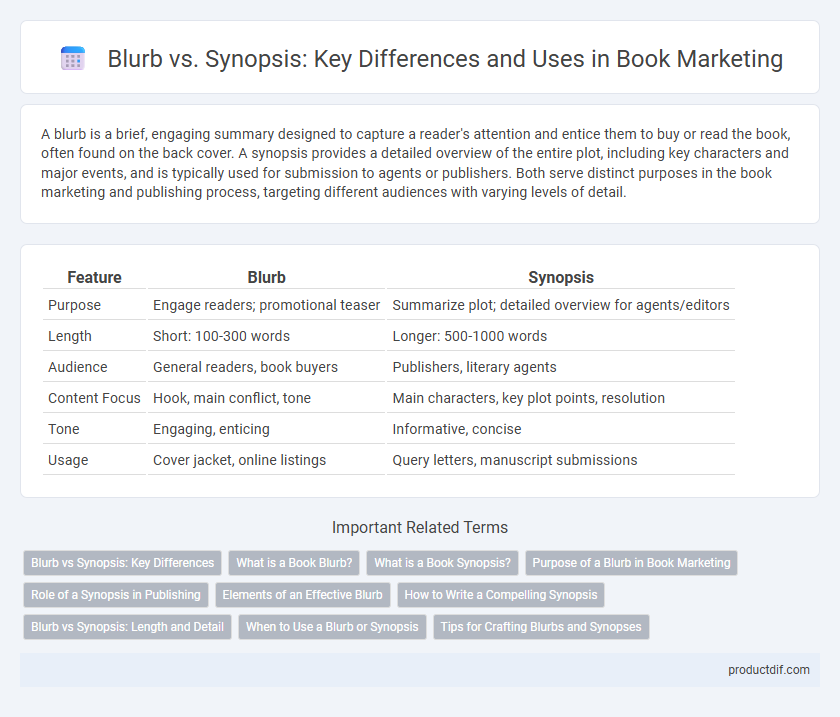A blurb is a brief, engaging summary designed to capture a reader's attention and entice them to buy or read the book, often found on the back cover. A synopsis provides a detailed overview of the entire plot, including key characters and major events, and is typically used for submission to agents or publishers. Both serve distinct purposes in the book marketing and publishing process, targeting different audiences with varying levels of detail.
Table of Comparison
| Feature | Blurb | Synopsis |
|---|---|---|
| Purpose | Engage readers; promotional teaser | Summarize plot; detailed overview for agents/editors |
| Length | Short: 100-300 words | Longer: 500-1000 words |
| Audience | General readers, book buyers | Publishers, literary agents |
| Content Focus | Hook, main conflict, tone | Main characters, key plot points, resolution |
| Tone | Engaging, enticing | Informative, concise |
| Usage | Cover jacket, online listings | Query letters, manuscript submissions |
Blurb vs Synopsis: Key Differences
A blurb is a concise, engaging summary typically found on a book's back cover, designed to hook readers quickly. A synopsis provides a detailed overview of the book's plot, characters, and themes, often used for submissions to agents or publishers. While blurbs emphasize marketing appeal with brevity, synopses prioritize comprehensive content to convey the full narrative arc.
What is a Book Blurb?
A book blurb is a concise, compelling summary designed to entice potential readers by highlighting the book's main themes and unique selling points, typically found on the back cover or online product page. It focuses on creating intrigue without revealing key plot details, aiming to capture the reader's interest quickly. Unlike a synopsis, which offers a detailed overview of the storyline, a blurb prioritizes persuasive, engaging language to motivate purchases.
What is a Book Synopsis?
A book synopsis is a concise summary that outlines the main plot, key characters, and central themes, offering a clear overview of the story's structure and progression. Unlike a blurb, which is designed to entice readers with a brief, engaging hook, a synopsis provides detailed insight into the narrative, often used by publishers and agents for evaluation. A well-crafted synopsis highlights major conflicts and resolutions, presenting a complete snapshot of the book's content without revealing every detail.
Purpose of a Blurb in Book Marketing
A blurb serves as a concise, compelling teaser designed to capture a reader's interest and encourage book purchases, often featured on the back cover or online listings. Its primary purpose in book marketing is to highlight the book's key themes and unique selling points without revealing major plot details. Unlike a synopsis, which provides a detailed summary, a blurb aims to create curiosity and emotional engagement to boost sales.
Role of a Synopsis in Publishing
A synopsis serves as a crucial tool in the publishing industry, providing agents and editors with a concise summary of a book's plot, character arcs, and themes. It highlights the narrative structure and key turning points, enabling professionals to assess a manuscript's potential quickly. Unlike a blurb, which is designed to entice readers, a synopsis offers a clear overview of the story's progression and resolution.
Elements of an Effective Blurb
An effective blurb captures the essence of the book by highlighting key characters, setting, and central conflict while maintaining brevity to engage potential readers quickly. It uses compelling language and a hook to spark curiosity without revealing major plot twists, differentiating itself from the more detailed and structured synopsis. Essential elements include a clear tone matching the genre, a concise overview of the storyline, and an invitation that encourages the reader to explore the book further.
How to Write a Compelling Synopsis
A compelling synopsis distills the essence of a book into a concise, engaging summary that highlights key plot points, main characters, and the central conflict without revealing spoilers. Writers should focus on clarity, maintaining a consistent tone that reflects the book's genre and style while including the story's stakes and resolution. Effective synopses balance informative content with intrigue to capture agents' or readers' interest quickly.
Blurb vs Synopsis: Length and Detail
A blurb typically ranges from 100 to 300 words, providing a concise and engaging overview designed to hook potential readers without revealing key plot points. In contrast, a synopsis is usually one to two pages long, offering a detailed summary that outlines the main characters, plot arcs, and themes to give a comprehensive understanding of the story. The blurb aims to entice, while the synopsis serves to inform publishers or agents about the book's full content and structure.
When to Use a Blurb or Synopsis
A blurb is ideal for book covers and marketing materials where a concise, engaging summary is needed to hook potential readers quickly. A synopsis serves best in submission packages or query letters, providing agents or publishers with a detailed overview of the plot, characters, and key themes. Choose a blurb to attract casual readers, and a synopsis when a comprehensive story outline is required for professional evaluation.
Tips for Crafting Blurbs and Synopses
Crafting effective blurbs and synopses involves clarity, brevity, and targeted information to engage readers quickly. Blurbs should highlight key themes and hooks within 150-200 words, using compelling language that sparks curiosity without revealing spoilers. Synopses require a concise yet comprehensive summary of the plot, character arcs, and major conflicts, typically ranging from 300 to 500 words, ensuring it serves both marketing and editorial review purposes.
Blurb vs Synopsis Infographic

 productdif.com
productdif.com